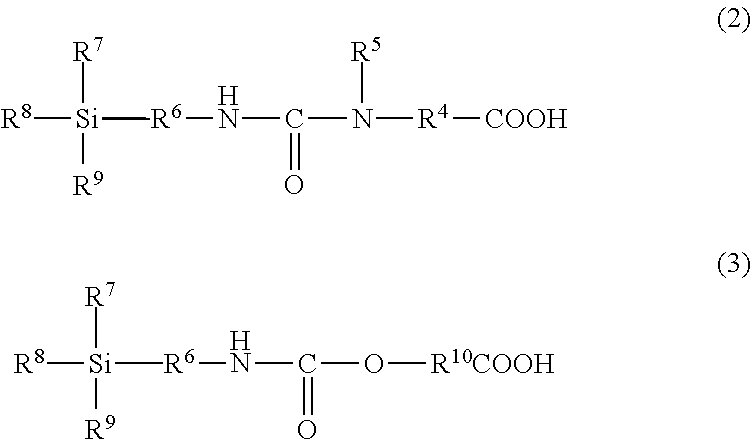Siloxane resin composition and protective film for touch panel using the same
a technology of siloxane resin and composition, which is applied in the direction of optics, microwave heating, electrical equipment, etc., can solve the problems of resistance film touch panels, which are currently the mainstream, cannot be subjected to high-temperature treatment, and low hardness and abrasion resistance, and achieve excellent abrasion resistance, high hardness, and superior pattern processing ability
- Summary
- Abstract
- Description
- Claims
- Application Information
AI Technical Summary
Benefits of technology
Problems solved by technology
Method used
Image
Examples
synthesis example 1
Synthesis of Carboxyl Group-Containing Silane Compound (A)
[0105]Into a 300 ml eggplant flask, 23.23 g of p-aminobenzoic acid and 209.05 g of propylene glycol monomethyl ether acetate (PGMEA) were charged, and the resulting mixture was stirred at room temperature for 30 minutes to dissolve the p-aminobenzoic acid. Into the resulting solution, 46.53 g of isocyanatepropyltriethoxysilane and 1.19 g of dibutyltin dilaurate were charged, and the resulting mixture was stirred for 1 hour in an oil bath of 70° C. Thereafter, the resulting solution was left standing to be cooled to room temperature, and the resulting precipitated solid was separated by filtering with a glass filter and dried to obtain a carboxyl group-containing silane compound (A). The yield of the carboxyl group-containing silane compound (A) was 46.7 g.
synthesis example 2
Synthesis of Carboxyl Group-Containing Silane Compound (B)
[0106]Into a 300 ml eggplant flask, 23.39 g of p-hydroxybenzoic acid and 210.5 g of PGMEA were charged, and the resulting mixture was stirred at room temperature for 30 minutes to dissolve the p-hydroxybenzoic acid. Into the resulting solution, 46.53 g of isocyanatepropyltriethoxysilane and 1.19 g of dibutyltin dilaurate were charged, and the resulting mixture was stirred for 3 hours in an oil bath of 40° C. Thereafter, the resulting solution was left standing to be cooled to room temperature, and the resulting precipitated solid was separated by filtering with a glass filter and dried to obtain a carboxyl group-containing silane compound (B). The yield of the carboxyl group-containing silane compound (B) was 42.4 g.
synthesis example 3
Synthesis of Polysiloxane Solution (i)
[0107]Into a 500 ml three-necked flask, 17.03 g (0.125 mol) of methyltrimethoxysilane, 19.83 g (0.1 mol) of phenyltrimethoxysilane, 38.42 g (0.1 mol) of the carboxyl group-containing silane compound (A), 41.02 g (0.175 mol) of γ-acryloylpropyltrimethoxysilane, and 109.61 g of diacetone alcohol (DAA) were charged, and to the resulting mixture, an aqueous solution of phosphoric acid, which was obtained by dissolving 0.237 g (0.2% by weight with respect to the weight of charged monomers) of phosphoric acid in 27.0 g of water, was added over 10 minutes by use of a dropping funnel while stirring the mixture with the flask immersed in an oil bath of 40° C. After stirring the mixture at 40° C. for 1 hour, an oil bath temperature was set at 70° C. and the mixture was stirred for 1 hour, and further the oil bath temperature was raised to 115° C. over 30 minutes. A temperature of the resulting solution reached 100° C. after a lapse of one hour from the st...
PUM
| Property | Measurement | Unit |
|---|---|---|
| thickness | aaaaa | aaaaa |
| temperature | aaaaa | aaaaa |
| weight loss rate | aaaaa | aaaaa |
Abstract
Description
Claims
Application Information
 Login to View More
Login to View More - R&D
- Intellectual Property
- Life Sciences
- Materials
- Tech Scout
- Unparalleled Data Quality
- Higher Quality Content
- 60% Fewer Hallucinations
Browse by: Latest US Patents, China's latest patents, Technical Efficacy Thesaurus, Application Domain, Technology Topic, Popular Technical Reports.
© 2025 PatSnap. All rights reserved.Legal|Privacy policy|Modern Slavery Act Transparency Statement|Sitemap|About US| Contact US: help@patsnap.com



